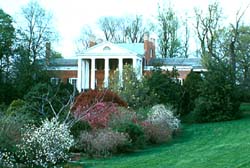
Oak Hill is a mansion and plantation located in Aldie, Virginia that was for 22 years a home of James Monroe, the fifth U.S. President. It is located approximately 9 miles (14 km) south of Leesburg on U.S. Route 15, in an unincorporated area of Loudoun County, Virginia. Its entrance is 10,300 feet (3,100 m) north of Gilberts Corner, the intersection of 15 with U.S. Route 50. It is a National Historic Landmark, but privately owned and not open to the public.

Waterford is an unincorporated village in the Catoctin Valley of Loudoun County, Virginia, located along Catoctin Creek. Waterford is 47 miles (76 km) northwest of Washington, D.C., and 7 miles (11 km) northwest of Leesburg. The entire village and surrounding countryside is a National Historic Landmark District, noted for its well-preserved 18th and 19th-century character.
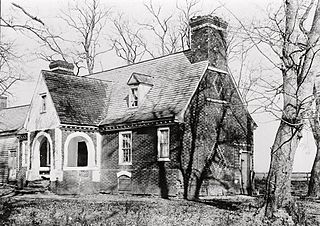
Malvern Hill stands on the north bank of the James River in Henrico County, Virginia, USA, about eighteen miles southeast of Richmond. On 1 July 1862, it was the scene of the Battle of Malvern Hill, one of the Seven Days Battles of the American Civil War.

Arcola is a census-designated place in Loudoun County, Virginia. The population as of the 2010 United States Census was 233.

Belmont Manor House, formally known as Belmont Plantation, is a two-story, five-part Federal mansion in Loudoun County, Virginia, built between the years of 1799–1802 by Ludwell Lee (1760–1836), son of Richard Henry Lee. The land surrounding the mansion, the Belmont property, was handed down to his first wife, Flora Lee, from their grandfather, Thomas Lee.

The Reynolds Homestead, also known as Rock Spring Plantation, is a historic plantation on Homestead Lane in Critz, Virginia. First developed in 1814 by Abraham Reynolds, it was the primary home of R. J. Reynolds (1850-1918), founder of the R. J. Reynolds Tobacco Company, and the first major marketer of the cigarette. It was designated a National Historic Landmark in 1977. The homestead is currently an outreach facility of Virginia Tech, serving as a regional cultural center. The house is open for tours.

The Hermitage near Charles Town, West Virginia is historic property which includes several buildings, as well as non-contributing tennis courts and a pool. The oldest structure is a small stone cottage dating to circa 1734, making it one of the oldest buildings in West Virginia. It resembles Prato Rio in nearby Leetown, West Virginia and may date to this property's first owner, Daniel Barnett, who was a partner in the Burr Iron Works circa 1740, the first of its kind in the state. A stone privy is also believed to be the oldest structure of its kind in the state.
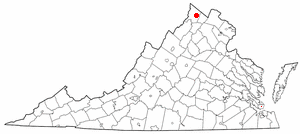
This is a list of the National Register of Historic Places listings in Winchester, Virginia.

Temple Hall is an early 19th-century Federal-style mansion and working farm near the Potomac River north of Leesburg in Loudoun County, Virginia.
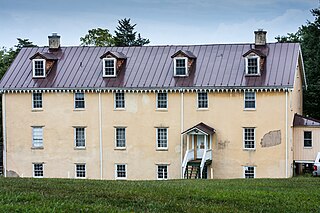
Institute Farm, also known as the Loudoun Agricultural and Mechanical Institute, was the first agricultural school in Virginia and one of the earliest institutions devoted to agronomy in the United States. Located near Aldie, Virginia, the school was established as the Loudoun County Agricultural Institute and Chemical Academy around 1854 on a former portion of U.S. President James Monroe's Oak Hill plantation.
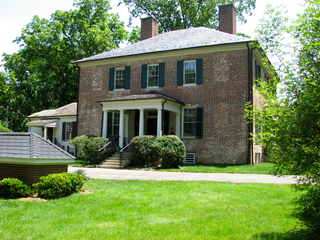
Fall Hill is a plantation located near the falls on the Rappahannock River in Fredericksburg, Virginia. Though the Thornton family has lived at Fall Hill since the early 18th century, the present house was built in 1790 for Francis Thornton V (1760–1836). The land on which Fall Hill is located is part of an 8,000 acres (3,200 ha) land patent obtained by Francis Thornton I (1657–1727) around 1720. The present-day town of Fredericksburg, Virginia is located on that original patent.
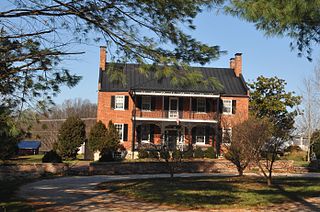
Rose Hill Farm is a home and farm located near Upperville, Loudoun County, Virginia. The original section of the house was built about 1820, and is 2 1/2-story, five bay, gable roofed brick dwelling in the Federal style. The front facade features an elaborate two-story porch with cast-iron decoration in a grape-vine pattern that was added possibly in the 1850s. Also on the property are the contributing 1 1/2-story, brick former slave quarters / smokehouse / dairy ; one-story, log meat house; frame octagonal icehouse; 3 1/2-story, three-bay, gable-roofed, stone granary (1850s); a 19th-century, arched. stone bridge; family cemetery; and 19th century stone wall.

Cleremont Farm is a historic home and farm located near Upperville, Loudoun County, Virginia. The original section of the house was built in two stages between about 1820 and 1835, and added onto subsequently in the 1870s. 1940s. and 1980s. It consists of a stone portion, a log portion, and a stone kitchen wing. It has a five bay, two-story, gable-roofed center section in the Federal style. A one-bay, one-story Colonial Revival-style pedimented entrance portico was built in the early 1940s. Also on the property are the contributing original 1 1/2-story, stuccoed stone dwelling (1761); a stone kitchen from the late 19th or early 20th century; a stuccoed frame tenant house built about 1940; a stone carriage mount; and a series of five stone walls.

Crednal is a historic home located near Unison, Loudoun County, Virginia. The building is an example of an early-19th-century, Federal-style, two-story, five bay, brick dwelling built in 1814, that was constructed around an existing 18th-century, vernacular, residential stone core. A two-story, three-bay frame wing was constructed in 1870. In 1993, a two-story, two-bay, Greek Revival-style brick dwelling that had been slated for demolition from Greene County, Virginia, was moved to the property and attached to the house by a hyphen. Also on the property are the contributing Carter family cemetery and an unmarked slave cemetery.

Huntland, originally known as New Lisbon, is a historic estate located at Middleburg, Loudoun County, Virginia. The original section was built in 1834, and is a two-story, five bay, Federal style brick dwelling. It built by master brickmason William Benton Sr., who also constructed nearby Oak Hill, the home of President James Monroe. In 1915, the house was remodeled and enlarged with side one-story brick additions and Colonial Revival-style detailing. The estate was also enhanced with gates, walls, and terraced gardens that are reminiscent of English manor estates and state-of-the-art kennels and horse stables. Also on the property are the contributing spring house, smokehouse, and a guest cottage, all constructed around 1834, and early-20th-century structures that include secondary dwellings, a dairy barn with attached silos and a corncrib, a milking parlor, five sheds, a garage, a pump house, and a cistern.

The Old Stone Church Site encompasses a location in Leesburg, Virginia that was the site of property of the Methodist church from c. 1770 to 1900. On May 11, 1766, Nicholas Minor, a founder of the new town of Leesburg, deeded a half acre of property to Robert Hamilton, a Methodist convert, for ″four pounds current money of Virginia, for no other use but for a church or meeting house and grave yard.″ The site is the earliest known Methodist-owned church site in America. On September 28, 1768, the deed was delivered to members of the Methodist society. The deed, recorded in Deed Book L at pages 451-453, may be seen today in the Clerk's office of the Loudoun Courthouse.

The Murray Hill Summer Home District is a collection of farmhouses and related buildings on Murray Hill Road, a rural road in Hill, New Hampshire. The area is distinctive as a cohesive collection of rural properties that were adapted for use as summer estates between 1873 and 1937, the start date representing an early transition from agricultural to tourist use of such properties in the state. The district has eight farmhouses that were adapted, and two Shingle style houses, as well as one 19th-century district schoolhouse that has been repurposed as a meeting space. All are located on Murray Hill Road between Cass Mill Road and Lynch Road. The district was listed on the National Register of Historic Places in 1988.

Fort Loudoun was a historic fortification of the French and Indian War, located in what is now Winchester, Virginia. The fort was built between 1756 and 1758 under the supervision of George Washington, then a colonel in the militia of the British Province of Virginia. It was named for John Campbell, 4th Earl of Loudoun, who commanded the British forces in North America for a time during the war. Washington and his militia regiment were headquartered at the fort for two years. The fort was a roughly square bastioned earthworks, whose extent spread across where North Loudoun Street runs.

Stoke is a historic farm property at 23587 Stoke Farm Lane in rural Loudoun County, Virginia, near the hamlet of Aldie. Its main house, set one mile down the entrance drive, is an 1840 Greek Revival farmhouse that underwent a major transformation in 1907 in the Renaissance Revival style. The property includes an early 20th-century swimming pool, tennis court, and landscaped garden with wall fountain, in addition to a complex of farm outbuildings, many dating to the 1920s. The gardens were developed by noted horticulturalist Eleanor Truax Harris.



























